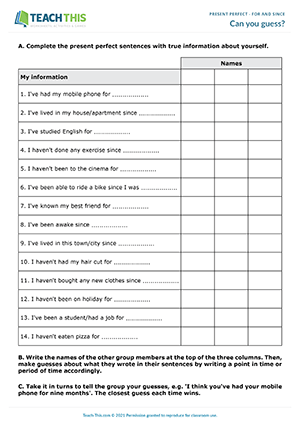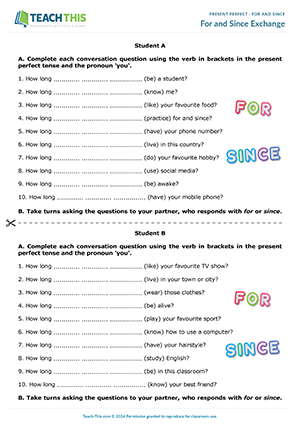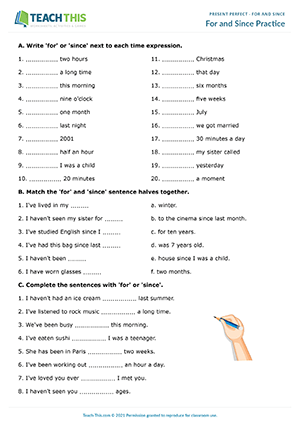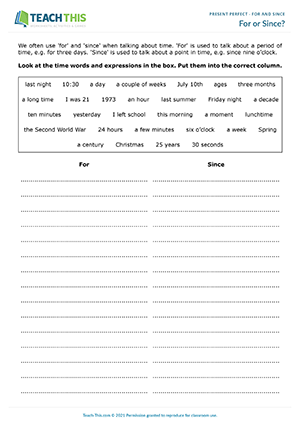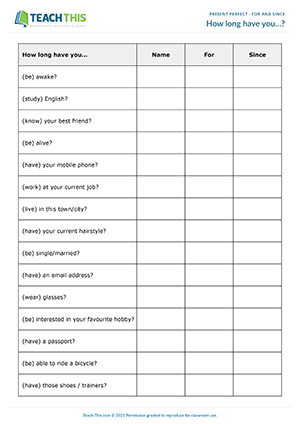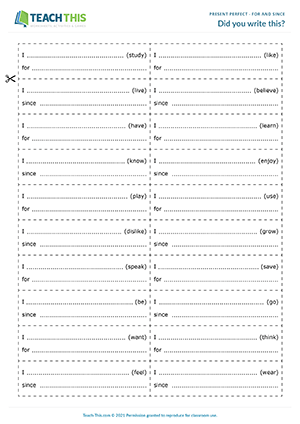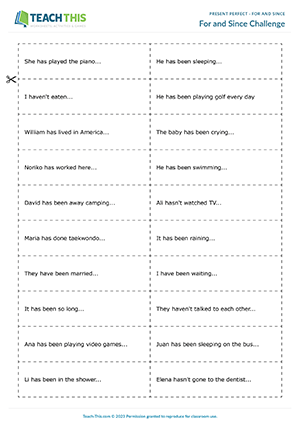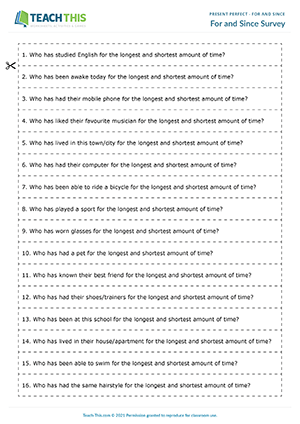Here is a fun for and since game to help students practice the present perfect and time expressions with for and since. First, students complete present perfect for and since sentences with true information about themselves. In groups, students then make guesses about what the other students wrote in their sentences by writing a point in time or period of time in a chart on their worksheet. Next, students take turns giving their guesses for one of the group member's first sentence. The three students do this by each making a sentence in turn, e.g. 'I think you've had your mobile phone for nine months', etc. When all three students have given their guesses, the other student reveals the correct answer. If a student guessed correctly, they score two points. If no one got the right answer, one point is awarded to the student(s) who gave the closest guess. Students then take turns giving their guesses for another group member's first sentence, and so on. The student with the most points at the end of the game wins.
In this insightful for and since speaking activity, students practice forming and asking How long have you...? conversation questions and responding with for and since. First, in two groups, students complete each conversation question using the verb in brackets in the present perfect tense and the pronoun 'you'. Next, students pair up with someone from the other group and take turns asking the How long have you...? conversation questions and responding with for or since. Afterwards, students share what they found out about their partner with the class.
In this free for and since worksheet, students identify and practice the use of for and since to express the duration of an unfinished action or event. To begin, students write for or since beside time expressions. Next, students match for and since sentence halves together. Students then complete sentences with for or since. Students then move on to rewrite sentences, changing present perfect sentences with for to present perfect sentences with since, or vice-versa. In the last exercise, students answer questions using for or since.
This entertaining for or since worksheet and game helps to teach students how to use for and since with time words and expressions. Students begin by reviewing the rules for using for and since with time words and expressions. Students then put time words and expressions into the correct for or since column on their worksheet. Next, give each student a set of for and since cards and have the students stand up. Call out various time words and expressions. After each word or expression has been called out, students hold up the correct for or since card. If a student holds up the wrong card or is too slow, they are out of the game and must sit down. Before a student sits down, they make a present perfect for or since sentence with the time word or expression they got wrong. The last student left standing wins the game.
In this engaging present perfect for and since activity, students practice time expressions with for and since by asking and answering How long have you...? questions in a class survey. Students start by changing the verbs in the questions on their worksheet into their past participle forms to create interview questions, e.g. 'How long have you been awake?' Students then stand up and go around the classroom asking a different question to each classmate. When a classmate replies to a question, they give two answers, one using the word for and one using the word since. The other student writes these answers and their name on the worksheet. Afterwards, students report back to the class on what they found out.
In this enjoyable for and since game, students complete present perfect simple and continuous for and since sentences with true information and then find out who wrote other sentences by asking How long have you...? questions. First, students write true present perfect simple or continuous for and since sentences, e.g. 'I have studied English for five years', or 'I have been studying English for five years.' All the students then fold up their sentences and put them in a box. Next, students find out who wrote each sentence by asking questions in the present perfect simple or continuous, according to the tense of the sentence. All the students stand up and take one sentence card from the box. Students then go around the class asking How long have you...? questions to find the person who wrote the sentence on their card. Students reply to questions by making complete present perfect sentences. When a student finds the person who wrote the sentence, they write the person's name on the card, keep it and take another one from the box. The student with the most sentences at the end wins the game.
In this free for and since game, students practice completing sentences with for or since and time expressions. In pairs, students take turns turning over one sentence card and one time expression card. If the time expression matches and can be used to form an appropriate sentence, the student reads the sentence aloud using for or since, keeps the two cards and has another turn. If the cards don't match or a sentence is formed incorrectly, the student turns the two cards back over, keeping them in the same place. The student with the most cards at the end of the game wins.
In this productive for and since speaking activity, students conduct a survey where they ask and answer How long have you...? questions. Give each student a question card, e.g. 'Who has had their bag for the longest and shortest amount of time?' First, students write the How long have you...? question they need to ask to answer the question on their card, e.g. 'How long have you had your bag?' Students then go around the class asking and answering their questions. Students reply to each question by making a present perfect sentence with for or since, e.g. 'I've had my bag for six months.' 'I've had my bag since 2022.' Students write the names of their classmates and replies on a separate piece of paper. When everyone has finished, students give feedback to the class on their results.
In this useful present perfect with for and since worksheet, students read about people who live on a street and complete exercises about them to practice the present perfect with for and since. Students start by reading about the people who live in the houses on Oak Avenue. Students then complete sentences about the people using verbs in the present perfect and for or since. Next, students write present perfect How long...? questions for a set of answers about the people. Finally, students write about what the residents of Oak Avenue have in common by making sentences with for or since.
Latest Free
Resources
- Count on Me!
Making Offers and Promises (A2)
Date Added: 11th of February
- It’s Carnival Time!
Cultural Celebrations (B1)
Date Added: 29th of January
- Identifying and Clarifying Problems
Dealing with Problems (B2)
Date Added: 1st of November
- The Bus Stop
Getting Around (B1)
Date Added: 1st of October
- Study Skills Showdown
Study Skills (B2)
Date Added: 10th of September
Latest Member
Resources
- Perfectly Played!
Present Perfect Wh Questions (B1)
Date Added: 25th of February
- Present Perfect Wh Question Time
Present Perfect Wh Questions (B1)
Date Added: 24th of February
- Express, Justify and Debate!
Speaking Test Preparation (B1)
Date Added: 20th of February
- Logical Fallacy Bingo
Critical Thinking (B2)
Date Added: 20th of February
- Staying Competitive
Business Problems (B2)
Date Added: 20th of February



